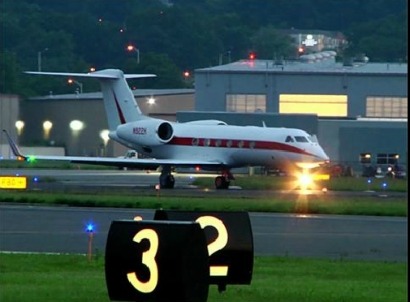
The biofuel was derived from camelina, a dedicated energy crop that does not compete in the food chain as it grows in rotation with wheat acreage and can also grow on marginal land. The feedstock for this flight was grown and harvested by Sustainable Oils, a US-based producer of camelina-based technology.
The flight, which was also the first business jet flight to be powered by a biofuel, departed from Morristown in New Jersey (US) at 9 p.m. on Friday [see inset] and arrived in Paris seven hours later. The jet closely followed the route taken by Charles Lindbergh’s famous first flight across the Atlantic, and carried executives from Honeywell who flew into the French capital to attend the industry's largest air show which is being held this week.More details about the Honeywell flight and its path can be found here.
Over 5 tonnes of carbon dioxide saved
Based on lifecycle analyses, use of Honeywell Green Jet Fuel on the flight saved approximately 5.5 metric tons of net carbon dioxide emissions compared to the same flight powered by petroleum-based fuel.
“This first biofuel trip across the Atlantic, along with more than a dozen other commercial and military test flights conducted to date, demonstrates that Honeywell Green Jet Fuel more than meets the demanding requirements for air travel,” said Jim Rekoske, vice president and general manager of Renewable Energy and Chemicals for Honeywell’s UOP. “Now that the initial ASTM International approval is in place, we are one step closer to commercial use that will help the aviation community reduce its carbon footprint and dependence on crude.”
"Gulfstream is committed to achieving business aviation's ambitious goals on emissions reductions," said Pres Henne, senior vice president, Programs, Engineering and Test for Gulfstream. "These include carbon neutral growth by 2020 and a reduction in total carbon emissions of 50 percent by 2050 relative to 2005. We are working with engine companies and other innovators, such as Honeywell, to ensure we can meet these initiatives. We are very proud to participate in this historic demonstration."
Advancing new sources of fuel
Fluctuating fuel prices combined with increased restrictions in aviation emissions regulations drive the demand for alternative sources of fuel. Honeywell Green Jet Fuel is a sustainable fuel option that meets all specifications for flight without any modifications to the aircraft or engine.
Honeywell has produced more than 700,000 gallons of Honeywell Green Jet Fuel from sustainable, inedible sources such as camelina, jatropha and algae for use in commercial and military testing. In each of the 16 biofuel flights conducted to date, Honeywell Green Jet Fuel proved that it meets all specifications for flight on military and commercial platforms without any modification to the aircraft or engines.
The process to produce Green Jet Fuel was originally developed in 2007 under a contract from the US Defense Advanced Research Projects Agency (DARPA) to produce renewable military jet fuel. The process is based on hydro-processing technology commonly used in today’s refineries to produce transportation fuels. It produces an aviation biofuel that can be blended seamlessly with petroleum-based fuel.
“With more than 500,000 gallons produced, camelina-based renewable jet fuel has been the most widely tested of any feedstock and has proven itself on more engine types and aircraft,” said Tom Todaro, CEO of Sustainable Oils. “It’s the only sustainable feedstock that is widely and commercially available today. We are proud to partner with Honeywell on this historic flight.”
While the Boeing flight ended up not being the first transatlantic flight using biofuel, it was the first bio-powered commercial flight. The US aircraft manufacturer also powered its new 747-8 design revealed at the start of the Paris Air Show this week using biofuel developed by UPO.
Elsewhere, on 1 July it is expected that the American Society for Testing and Materials (ASTM), which oversees the specification and certification of jet fuels in the US, will publish new rules enabling biofuels to be used in all commercial flights.
For additional information:

